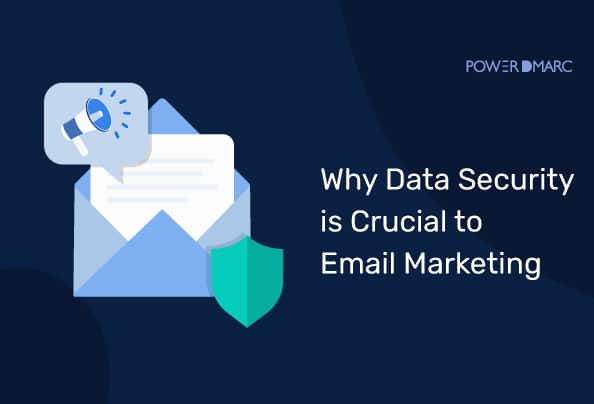Reading Time: 8 min
Data security is an important issue to address if you want to effectively use email marketing to acquire and retain customers. The data security threats you may encounter can cause your company serious financial losses and reputational risks. The key areas where you can protect data are how you send emails and how you collect and store data for use in future campaigns.
In this article, you will learn about the main data security threats companies and their customers face and effective strategies for overcoming them.
Importance of Data Security in Email Marketing
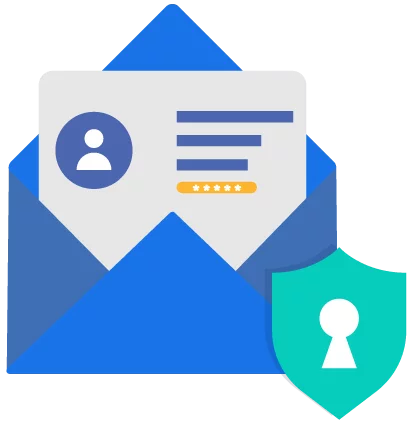
More and more companies are facing a variety of cyber threats that can significantly affect their reputation and financial stability. From phishing to data loss, email is a prime target for cybercriminals. That’s why knowing how to protect your emails and data is critical.
According to IBM’s Cost of a Data Breach Report 2023, the global average cost of a data breach in 2023 was $4.45 million, a 15% increase from the previous three years.
Data protection is also a question of maintaining client trust for companies that use email marketing. Personalization is a key trend for effective email marketing, so user data is needed.
For your customers to share data with you, they need to trust that you are keeping it secure. In addition, if your emails look like phishing emails, scam email clients will simply send them to the spam box, and your email marketing will not get results.
For third-party tools, the challenge is also to protect the data of their clients and their subscribers.
For all these reasons, email marketers must apply the best email security practices, which we will discuss.
Cases of Data Breaches in Email Marketing
In my experience, I have observed (and continue to observe), for us and our clients, the four most prevalent data security threats that come via email.
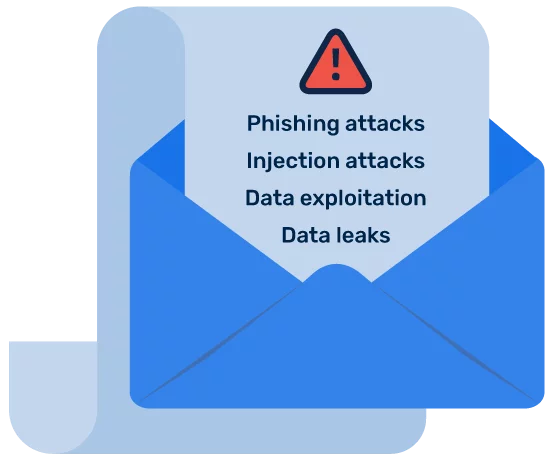
Phishing attacks
The most famous case, which is crucial to protect against, is phishing emails. In this attack, hackers send emails that pretend to be yours and ask your customer to do something in your name—for example, to provide sensitive information—by sending emails that look legitimate.
According to the 2024 Phishing Report by the Zscaler ThreatLabz team, phishing attacks increased by 58.2% in 2023 compared to the previous year. Phishing threats reached new difficulty levels in 2023, driven by the growth of generative AI tools.
Injection attacks
Injections are another common threat. Attackers add a malicious script to email subscription form fields. For example, in the field “Your first name,” they write “earn 500 dollars in 20 minutes” and give a link. When a person receives such an email from a trusted service, he simply clicks on a malicious link and runs a script—then the attacker can access the admin panel, hack something, or get data.
To avoid injection attacks, you need to carefully check and validate the values of the fields you have. Whether or not your service is popular, hackers may try to hack it.
Data exploitation
Another problem is when attackers steal data from emails and use it to hack into systems. For example, contacts’ hidden IDs, cache information, or other personalized data that somehow ended up in the email can be used to gain access to the system. To avoid this, it is important to minimize the use of such data in emails and ensure their reliable storage.
Data leaks
Data leaks happen when somebody uses your admin account with email to send messages to your customers or export private data. As a result, confidential information is lost or misused. To avoid this, it is necessary to ensure proper data access control, data encryption, and regular monitoring.
There are many more threats, and you should understand how easily data can be compromised. We can suggest several best practices for protecting it.
Key Areas to Focus on for Data Security in Email Marketing
To ensure email security, consider the four main areas where you can easily protect data and understand that you, and not some other system, are responsible for this protection.
For all these areas, it is critical to know what you need in order to organize the process, how to monitor to prevent something going wrong, and how to constantly review.
Let’s understand everything one by one.
1. How do you send emails?
When sending emails to your subscribers, you need to minimize the possibility of data loss or cybercriminals using your emails. Here are some methods you can use.
- Implement DKIM, SPF, DMARC, and BIMI
To make emails sent from your business domain as secure as possible, you can add email authentication DNS records for SPF, DKIM, and DMARC protocols. These protocols help validate the authenticity of emails and the legitimacy of sending sources.
An additional way to verify legitimacy is BIMI and Gmail’s blue verified checkmark. Once you implement BIMI, you can display the company logo in the mailbox along with a blue verification mark, as shows below:
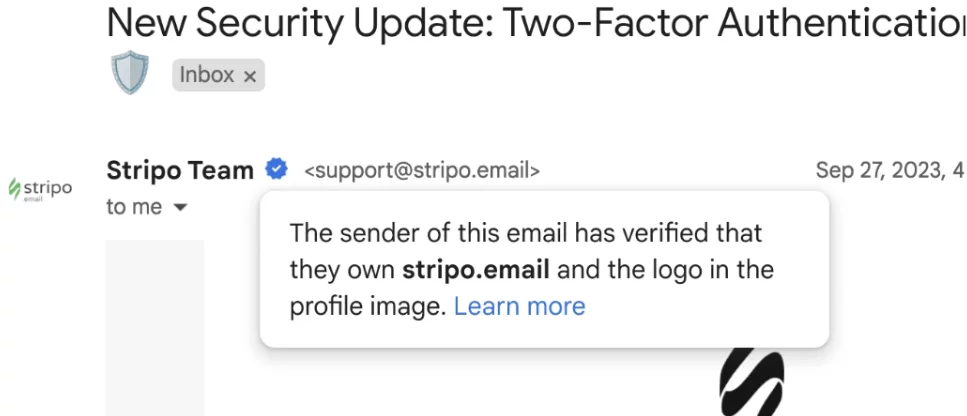
- Use email validators and check for spam traps
Email validators check that an email address is valid, is formatted correctly.. Spam traps are email addresses created precisely to catch spammers. They are not used for legitimate communication, so any email sent to a spam trap is considered unwanted and possibly malicious.
Use email validators periodically to clean and maintain your email lists. This helps remove invalid addresses and identify potential spam traps.
- Implement fallback strategies
Fallback strategies protect against unexpected issues that could compromise email data security. Regularly back up email data to secure and accessible locations. This ensures that emails can be restored in case of data loss or corruption.
- Work with postmasters for better deliverability
Postmaster is one such tool you can use to analyze email performance. It helps you determine your spam score, IP and domain reputation, and delivery errors. Use the postmaster information of the popular email clients Google, Yahoo, and Outlook to ensure you’re on track.
Alternatively, you can review your DMARC reports and IP reputation on the PowerDMARC dashboard to analyze your email’s deliverability and performance. This is a one-stop solution to manage and monitor your email sending activities and email authentication processes.
Track bounced emails based on the recipient domain to identify and avoid spam traps and sending them to invalid or malicious addresses that can damage your reputation. High bounce rates can signal security issues, such as a compromised sending server or a phishing attack.
Monitoring and reviews
All these methods are important not only to implement once but also to use for continuous monitoring, namely, to check email authentication reports, to track all indicators, and also to review DKIM, SPF, and DMARC policy updates.
2. How do you store data?
To conduct effective email marketing, you need to collect and store subscribers’ data. Good data storage practices are crucial to protecting this data from hackers.
Here are some tips that help you store the data safely.
- Use strong passwords and encryption keys
Protect access to email accounts and the data they contain by ensuring that passwords are complex, unique, and regularly updated and that encryption keys are strong and securely managed. This prevents unauthorized access and data leaks, protecting sensitive information.
- Implement secure data storage solutions
Use your own services to store images and other data to avoid problems associated with using third-party services that may be blocked due to spam activity. You have to stand out as much as possible from services that may indirectly harm you.
Here is an example of what can happen. If you use some third-party image storage service, and at some point it becomes spammy because spammers have also started using it en masse, the service will be blocked by all email clients, and you along with it.
Because of this, we create all the links in our own domain for all emails created in Stripo, which allows us to avoid blocking problems and increases the level of security. You can also use your own IPs, but if you have a lot of data, you will have to buy more, which does not always make sense.
- Ensure that the services where you store your data are secure and certified
If you use third-party tools, ensure they comply with all necessary security standards. Otherwise, your data may be inadequately protected, creating additional risks. Hackers can do anything; your security needs to be top-notch to minimize these risks.
When choosing a system for work, pay attention to the duration of the company’s work on the market. Small systems that have only recently appeared often face security issues as they gain popularity. This can lead to serious breaches and the need for a complete system rebuild, which can cost the entire business.
Make sure that the service you will use has one or more of these points:
- it has passed the necessary certifications recognized and known in the industry, such as data security certification SOC 2, the certificate for the international security standard “ISO/IEC 27001:2013”, and Google’s CASA assessment;

- all processes, both documentary and infrastructural, are configured to ensure the highest level of security;
- it has a special department that deals with internal action protocols and a transparent system of notifying customers in case of problems (for example, in the Stripo editor, we manually moderate each email created by clients and track requests to create phishing emails);
- and, for example, is recognized as safe by the white-Hat hacking community.
Monitoring and reviews
To maintain the security of your data storage, regularly monitor access logs, check the system for unauthorized access attempts, monitor encryption standards and update as needed, and change passwords and encryption keys.
3. How do you organize and control access to data?
The next factor influencing data security is who will access it and how. This applies to company data and to customer, user, and subscriber data.
To protect them, pay attention to the following:
- Implementing multi-factor authentication (MFA) is a very underrated approach. Many companies do not use MFA, thinking it is optional. However, experience shows that it helps increase security and reduces the risk of unauthorized access to the system.
- Implement and review your user access controls—giving everyone admin roles or allowing data exports and imports is a common mistake. Confidential information should be limited only to those employees who really need it to perform their duties. Employees should not have access to exported databases to avoid the risk of their unauthorized use. Most often, leaks occur precisely because of disgruntled employees who had access to databases and decided to take advantage of this opportunity.
- Monitor for suspicious activity (exports, imports, triggers, segment size). To prevent data leaks, monitor user activity and analyze access patterns regularly. If you notice unusual activity, such as frequent use of triggers or changes in user roles, this may be a signal for further investigation. For example, if someone regularly exports large amounts of data or if former employees still have access to the system, this could indicate a potential threat.
- Using seed addresses to detect data leaks entails creating and using unique, trackable email addresses to monitor where data might be improperly shared or leaked. If these seed addresses receive unexpected emails, this can indicate that data has been exposed, helping to identify and mitigate breaches.
Monitoring and reviews
To maintain control over access to sensitive data, monitor user access patterns for anomalies, track export, import, and launch events, and regularly review segment sizes for inconsistencies, MFA effectiveness, and unusual activity on source addresses.
4. How do you use data in new email campaigns?
A simple rule of email marketing is to collect and use only the user data necessary to improve the effectiveness of your email campaigns.
So when preparing your emails, make sure they are relevant to Best practices of secure email design and that you take into account the following:
- never include customers’ sensitive information in links or personalization in case that email is resent or shared with another person who can use this data. Data used for personalization should be minimal and well-protected;
- validate the values of all the contact fields you collect, check for possible injection of the values, and do not allow automatic data processing without verification.
Monitoring and reviews
Remember to regularly monitor emails for misuse of personal information and injection vulnerabilities. Pay special attention to email templates, personalization settings, and penetration testing of contact fields.
Summing up
Ensuring data security is a constant process that requires a proactive approach, attention to detail, and regular updates. Following the recommendations in this article will help you minimize your risks and protect your and your customer’s data from unauthorized access. Monitor for new threats, improve your protection methods, and choose reliable partners to keep your email marketing secure.
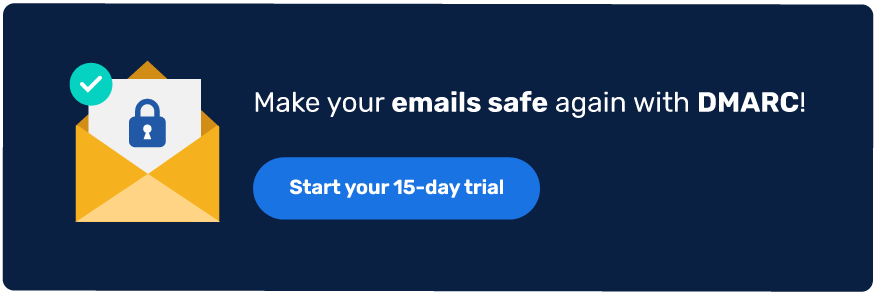
*** This is a Security Bloggers Network syndicated blog from PowerDMARC authored by Ahona Rudra. Read the original post at:

